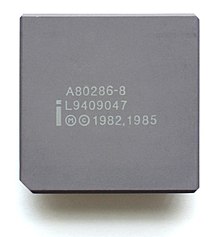Intel 80286

An 8MHz Intel 80286 Microprocessor
|
|
| Produced | From 1982 to early 1990s |
|---|---|
| Common manufacturer(s) | |
| Max. CPU clock rate | 6 MHz (4 MHz for a short time) to 25 MHz |
| Instruction set | x86-16 (with MMU) |
| Model | 80286 Series |
| Data width | 16 |
| Address width | 24 |
| Predecessor | 8086, 8088 (while 80186 was contemporary) |
| Successor | Intel 80386 |
| Co-processor | Intel 80287 |
| Package(s) | |
The Intel 80286 (also marketed as the iAPX 286 and often called Intel 286) is a 16-bit microprocessor that was introduced on 1 February 1982. It was the first 8086 based CPU with separate, non-multiplexed, address and data buses and also the first with memory management and wide protection abilities. The 80286 used approximately 134,000 transistors in its original nMOS (HMOS) incarnation and, just like the contemporary 80186, it could correctly execute most software written for the earlier Intel 8086 and 8088 processors.
The 80286 was employed for the IBM PC/AT, introduced in 1984, and then widely used in most PC/AT compatible computers until the early 1990s. Although now long since obsolete for use in personal computers, 80286 based processors are still widely used in embedded microcontroller applications.
Intel's first 80286 chips were specified for a maximum clockrate of 4, 6 or 8 MHz and later releases for 12.5 MHz. AMD and Harris later produced 16 MHz, 20 MHz and 25 MHz parts, respectively. Intersil and Fujitsu also designed fully static CMOS versions of Intel's original depletion-load nMOS implementation, largely aimed at battery powered devices.
On average, the 80286 was reportedly measured to have a speed of about 0.21 instructions per clock on "typical" programs, although it could be significantly faster on optimized code and in tight loops as many instructions could execute in 2 clock cycles. The 6 MHz, 10 MHz and 12 MHz models were reportedly measured to operate at 0.9 MIPS, 1.5 MIPS and 2.66 MIPS respectively.
...
Wikipedia
